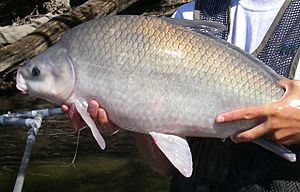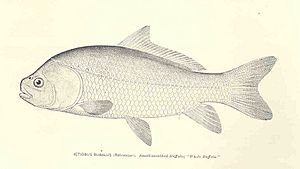Smallmouth buffalo facts for kids
Quick facts for kids Smallmouth buffalo |
|
|---|---|
 |
|
| Conservation status | |
| Scientific classification | |
 |
|
| The distribution of I. bubalus in the United States | |
| Synonyms | |
|
The smallmouth buffalo (Ictiobus bubalus) is a fish that lives in fresh water. Its name comes from Greek words meaning "bull-fish" and "buffalo." You can find it mainly in the Mississippi River and its connecting waters in the United States. It also lives in some other places where people have moved it.
This fish is strong and can live a long time. It looks a bit like its relatives, the bigmouth buffalo and the black buffalo. The smallmouth buffalo has a mouth that points downwards, which helps it find food on the bottom. The bigmouth buffalo's mouth points forward. Also, the smallmouth buffalo has bigger eyes than the black buffalo.
Even though they look similar, the smallmouth buffalo is not a common carp. A key difference is that buffalo fish do not have the whisker-like feelers called barbels that carp have around their mouths.
Contents
Physical Features of the Smallmouth Buffalo
Smallmouth buffalo fish can be different colors. Their backs might be gray, brown, or even coppery green. Their bellies are usually pale yellow to white. Their fins match the color of the body part they are attached to. The tips of their fins are often darker.
These fish are known for being stocky, meaning they are thick and strong. They have a noticeable hump that rises behind their head. Their fins are well-placed for swimming. The tail fin has two even parts. The fin on their back starts at the hump and runs along the rest of their body.
Most adult smallmouth buffalo are about 40 to 60 centimeters (16 to 24 inches) long. Some can grow much larger. The biggest one ever caught weighed 30.1 kilograms (66.4 pounds) and was 101.5 centimeters (40 inches) long. An amazing record fish weighing 82 pounds 3 ounces was caught in Lake Athens in 1993.
Where Smallmouth Buffalo Live
The smallmouth buffalo is a very tough fish. It likes to live in clear streams that move at a moderate to fast speed. Sometimes, you can also find them in lakes and ponds. They prefer places with lots of water plants and a soft, muddy bottom.
These fish can handle different water conditions. They are good at living in "hard water," which means water with many minerals. They can also survive in water with a pH level between 6.5 and 8.5.
What Smallmouth Buffalo Eat
The smallmouth buffalo mainly eats detritus. This means it uses its downward-pointing mouth to pick up tiny bits of plants and other organic matter from the bottom. It also likes to scrape algae off rocks.
This fish also eats many small creatures without backbones, called invertivores. Its diet includes tiny water animals called zooplankton. It also eats insect larvae, tiny mollusk larvae, and small crustaceans.
Life Cycle and Reproduction
Smallmouth buffalo usually spawn (lay eggs) in the spring and summer. The exact time depends on where they live. They do not travel far to lay their eggs. Spawning often happens in shallow parts of streams. The eggs stick to plants and gravel so they don't float away.
A female fish can lay tens of thousands to hundreds of thousands of eggs at one time. The number of eggs depends on her size. The parents do not take care of the eggs or the young fish. The eggs usually hatch in one to two weeks. The young fish hide in water plants to stay safe from predators.
Smallmouth buffalo can live for a very long time. Scientists have found some fish that were 20 years old or more. One female fish found in Oklahoma was an incredible 62 years old! Male smallmouth buffalo are ready to reproduce when they are about 4 to 5 years old. Females are usually ready around 6 years old.
Smallmouth Buffalo and People
For a long time, some people thought of smallmouth buffalo as a "rough fish." However, they are native to North America and are very important. They are the most common freshwater fish sold in the United States. Many traditional anglers enjoy catching them.
Recently, the smallmouth buffalo has become a popular sportfish. This is especially true for modern night bowfishing, which has grown in popularity since 2010. This sport targets smallmouth buffalo and other fish. Because of this, it's important to manage how many fish are caught to keep their populations healthy.
Many people value smallmouth buffalo as a food source. Fish meal made from them is also used in animal feed. They are relatively easy to raise in fish farms. If you want to catch a smallmouth buffalo with a hook, people have had good luck using dough balls and corn. The world record for a smallmouth buffalo caught by rod and reel is 82 pounds 3 ounces. It was caught in Lake Athens, Texas, in 1993.
Images for kids
See also
 In Spanish: Ictiobus bubalus para niños
In Spanish: Ictiobus bubalus para niños





